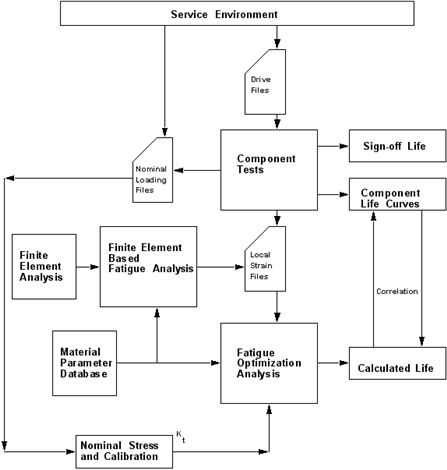XXXXXXXXXXXXXXXXXXXXXXXXXXXXXXXXXXXXXXXXXXXXXXXXXXXXXXXXXXXXXXXXXXXXXXXXXXXXXXXXXXXXXXXXXXXXXXXXXXXXXXXXXXXXXXXXXXXXXXXXXXXXXXXXXXXXXXXXXXXXXXXXXXXXXXXX''"> Technology Integration for Durability Management
Durability Management is the control and organization of design, test, and production, to ensure products are developed to meet the required life within cost and on time. The process has evolved over the last 150 years since fatigue failures were first recognized. While there are many technologies that have contributed to the understanding of fatigue and to the solution of fatigue problems, two major procedures are used in durability management: fatigue testing and fatigue modelling.
Fatigue Testing
The first fatigue tests were carried out on full-scale components to establish their safe working stress. Later, the more complete relationship between cyclic stress or strain and fatigue life was established. Small scale specimens were tested to study component life and also fatigue mechanisms. In more recent times, as tests had to become increasingly realistic, special test techniques were developed such as Remote Parameter Control. Today, testing is still the most common way of confirming the fatigue life of a product prior to releasing it onto the market. However, testing often reveals weaknesses which necessitate re2wdesign. Assessing the suitability of particular design modifications using fatigue testing alone can be time consuming and cost far more than just a delayed product.
Fatigue Modelling
The estimation of fatigue life using mathematical modelling techniques was developed to assist the engineer in solving fatigue problems without always having to physically test all the options. For this reason, techniques such as local strain or crack initiation modelling have become widely used. Improvements in the power of computers have enabled the effective use of these techniques. Today, most major companies designing mechanical structures will use a fatigue life estimation tool such as MSC Fatigue in conjunction with testing. By the late 1980s the use of finite element analysis (FEA) had become established as a tool for stress analysis. At the same time the integration of FEA and fatigue life estimation through the MSC Fatigue product began to provide new benefits by assessing fatigue earlier in the development process.
Integrated Durability Management
Understanding and effective implementation of durability management strategies require a partnership between test and design analysis. It can reduce product lead time by focusing the use of fatigue testing to the essential correlation and sign-off tests. The use of fatigue modeling, at the design analysis stage, allows more options to be assessed for little incremental cost. Integrated durability management can produce better products more quickly and cheaply.
Figure 1‑1 illustrates some of the links and benefits from this integration. In summary they are:
• Correlation of test and analysis to improve the accuracy of analytical design optimization
• Early fatigue life estimates in the design process leading to better products earlier
• Analytical fatigue design optimization based on realistic descriptions of service environments.
With reference to
Figure 1‑1, service environment descriptions can be edited to produce drive files for fatigue test or nominal loading data for use in FE based fatigue analysis. Fatigue optimization analysis may be carried out on local structural response histories extracted from the FEA based fatigue simulation or from measurements made on structures under test. Early estimates of life at the design stage can be made using nominal stress data and calibration. Correlation between component test lives and calculated lives form an important step in developing appropriate analytical procedures for specific components.
Figure 1‑1 Schematic for Integrated Durability Analysis

